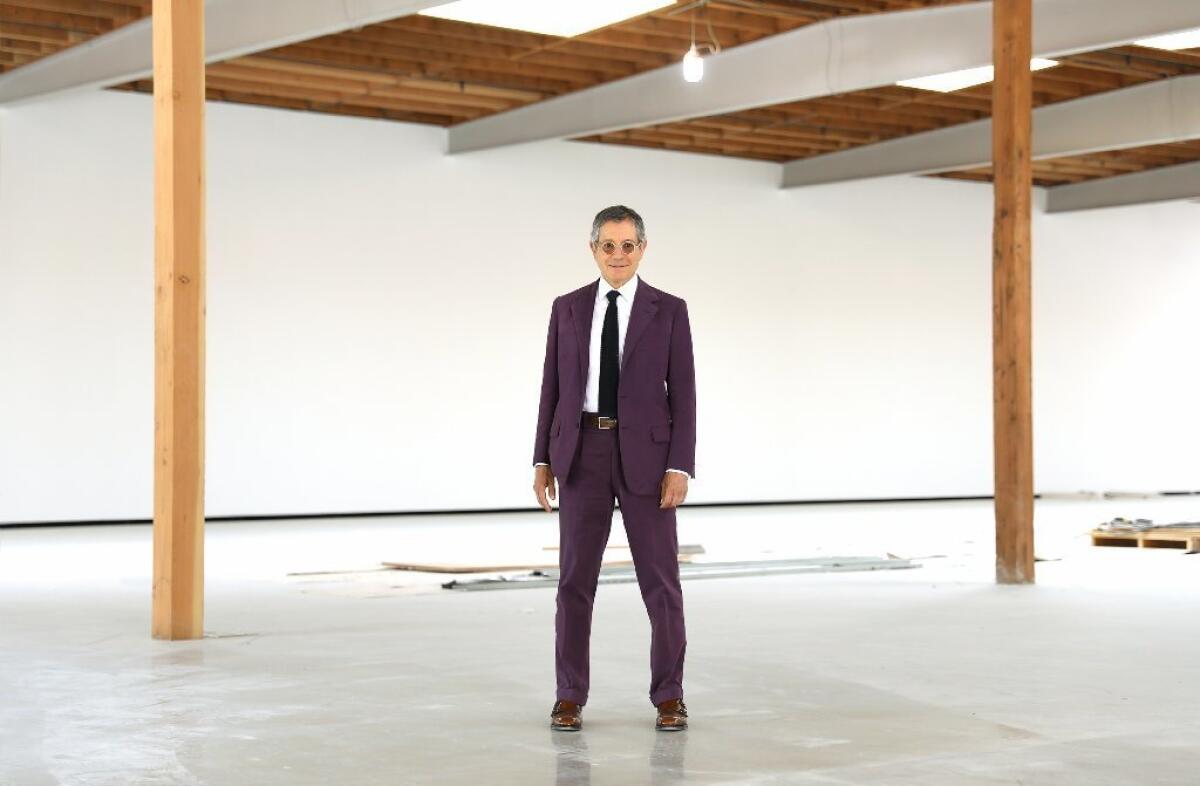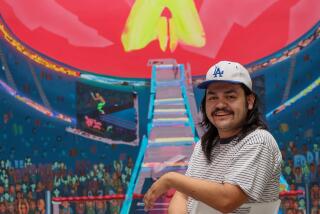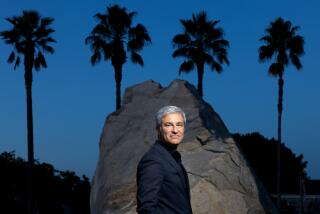Jeffrey Deitch left MOCA amid controversy. Now he’s returning to L.A. to launch a gallery on his own terms

- Share via
As director of Los Angeles’ Museum of Contemporary Art from 2010-13, Jeffrey Deitch was responsible for some ambitious, populist and pop cultural exhibitions, including 2011’s “Art in the Streets,” a historical survey of graffiti and street art that drew record crowds at the time, and a James Franco-organized show about the 1955 James Dean film “Rebel Without a Cause.” But his penchant for cross-disciplinary flash and sizzle was also a source of controversy at MOCA. The museum’s chief curator, Paul Schimmel, departed in 2012, followed by four artist board members. Deitch resigned in 2013 and while he kept a residence in L.A., he also returned to New York, reopening his eponymous gallery in 2016.
Now Deitch has resurfaced in the L.A. art world.
His new gallery, Jeffrey Deitch, opens Sept. 29 at 925 N. Orange Drive in an art hub of Hollywood near Regen Projects, Kohn Gallery and LAX Art. The inaugural exhibition is a solo show of work by Chinese artist Ai Weiwei. The space, a 15,000-square-foot warehouse that once housed lighting equipment for film shoots, was renovated by Frank Gehry. It’s streamlined and bright, with rolling glass garage doors and multiple UV-filtered skylights.
“I just love the light,” Deitch says, during an early tour of the space. “For people coming from different parts of America, coming from different countries,” he says, “this is a really L.A. space. And that’s what I wanted — an only-in-L.A. space.”
In this edited conversation below, Dietch explains the vision for his new gallery, his thoughts on MOCA’s new director and what inspires him about L.A.
What makes the space so “L.A.”?
I was introduced to this area by David LaChapelle. His studio is right up there. I love the history. Paramount Pictures is nearby, the old United Artists studio is five minutes away, all these legendary studios. Hollywood created so much of the world’s pop culture, it still does. It’s meaningful that we’re part of that history.
When you talk about California art of the ’60s, people use the term light and space. And that’s what we have here, that’s the heritage. I wanted to have expansive space, so we could present the most beautiful environment, and I wanted natural light because we have such a gift of it here in Los Angeles. It’s also similar to artists’ studios. Some artists have big warehouses like this, not necessarily quite as finished, but this is how art is made here too.
What’s the focus of the gallery, what can we expect to see?
The main focus will be big solo exhibitions that are museum-level shows. And then curated exhibitions, with 20 or so artists, that are thematic exhibitions. Great international artists of all generations. In fall 2019, we’re doing a giant show of Judy Chicago’s work from L.A. in the ’60s. One show I’ve been working on for a long time is called “Unrealism.” We did a short version of it in Miami in 2015, a collaboration with Larry Gagosian, and it was about new figurative painting.
The main Ai Weiwei piece will be these 6,000 antique stools that will fill out the whole center [of the gallery]. It’s a very complex piece. And then a kind of focused survey. I wanted to open with an artist where obviously the work is great, the work is important, but also an artist that has something to address way beyond the inside art world. I don’t just want the inside art world to come. I want people who are interested in human rights and film and poetry, Chinese-American relations. He will bring in a much broader audience. That’s part of the mission — I’ve always tried to go beyond the insider art audience and bring in new people.
What’s it like returning to the art world spotlight in L.A. after having had such a publicly tumultuous run at MOCA?
There was tremendous enthusiasm from a broad audience about what I did there — not just kids who went to “Art in the Streets,” but patrons, all kinds of people. And I remain friends with so many of these people. So it was a very strange situation where there was a lot of enthusiasm in part from the public for what I was doing, and from people in the universities and city government, and it is a very narrow group, even before I got there, that for whatever reason didn’t want me there. And they succeeded in driving me out. But that was not enough to topple my mission. This is like a museum-type space; I don’t need the board and all that trouble. I can do whatever I want here. I have zero bitterness. I love L.A.
You have a unique insider-outsider perspective on the L.A. art world. How have you seen the art scene change here over the last eight or so years as you’ve journeyed through it?
Until fairly recently, it was dominated by these cliques. The cool school artists, the feminist artists who felt they were not getting the recognition, the groups connected with the schools – UCLA and CalArts – and there was a kind of competitiveness, a feeling that certain groups had their turf. And outsiders coming in felt this. What’s happened in the past five years, especially, is the influx of all of these people coming from different cities who didn’t go to art school here and who aren’t part of these cliques. So it’s now a much more open situation. Then there’s new community groups like the Underground Museum, which is so important. There are these very powerful new communities and the situation is much more diverse, ethnically and internationally. It’s really changed a lot.
What are your thoughts about the newly appointed MOCA director, Klaus Biesenbach?
I’m thrilled. He’s not just another museum guy. This is one of the most exceptional people in contemporary culture of the past 30 years. He established the Berlin Biennale. The Kunst-Werke [KW Institute for Contemporary Art]. His contribution to what happened in Berlin is so enormous, so important. And he created such a vital program at MoMA PS1, and he had such an important impact on the Museum of Modern Art bringing in the Marina Abramović show and Yoko Ono and expanding this robust institution and what their definition of what art can be. He’s an exceptional person, a brilliant choice.
What L.A. art is inspiring you these days?
Charles Ray, for me, is one of the great artists of our time. His work is so profound. A few months ago I went to Sam Falls’ studio and I was just stunned by how great the work was. The most stimulating show I saw this summer was of Norm Laich’s work for hire, [“This Brush for Hire” at ICA LA]. Sam Parker opened a gallery in a mansion in Los Feliz and he had this fantastic historical show, “The Candy Store,” about a little-known but historic gallery in Folsom. L.A.’s attracting people doing really fascinating, focused galleries like this.
Reading/listening/eating?
The book I’m reading right now is about Duchamp’s supposed non-art activities by Elena Filipovic, “The Apparently Marginal Activities of Marcel Duchamp.” Great scholarship. I went to such a great concert, David Byrne at the Shrine Auditorium. I go to the Hollywood Bowl in the summer almost every Tuesday and Thursday for classical concerts and Dudamel is just so phenomenal and inspiring. The most enjoyable restaurant I went to [recently] is a semi-Israeli restaurant, Mh Zh, on Sunset.
That’s one of the things that’s great about L.A. – it’s every creative field, food, music, art, classical music, new music.
It’s so great for me to be a part of this.
Follow me on Twitter: @debvankin
More to Read
The biggest entertainment stories
Get our big stories about Hollywood, film, television, music, arts, culture and more right in your inbox as soon as they publish.
You may occasionally receive promotional content from the Los Angeles Times.











